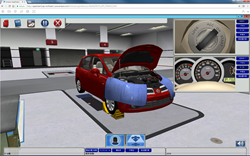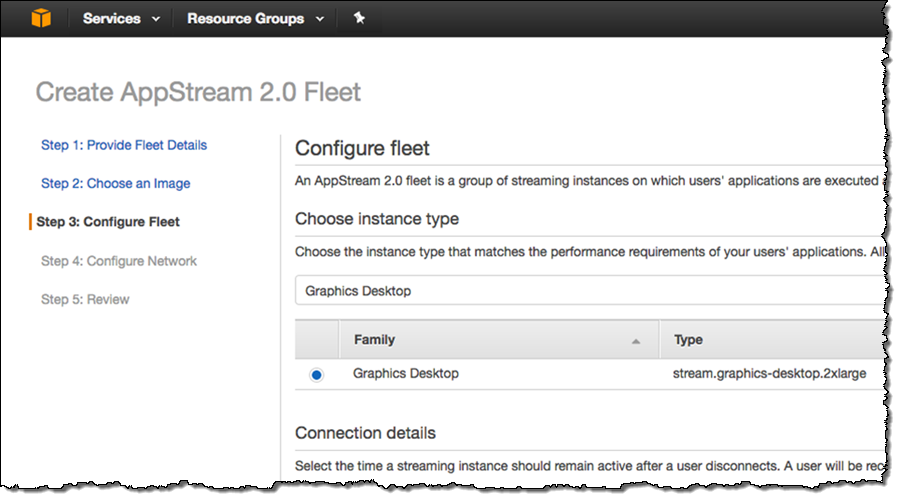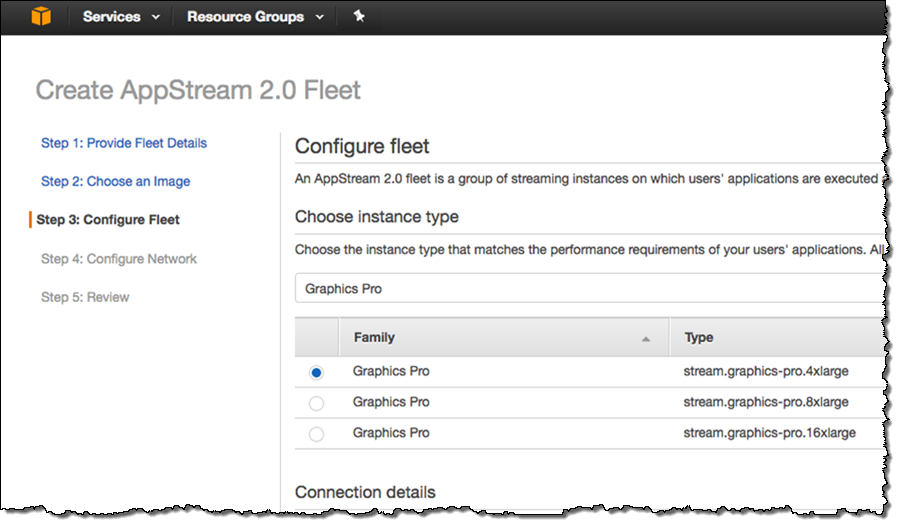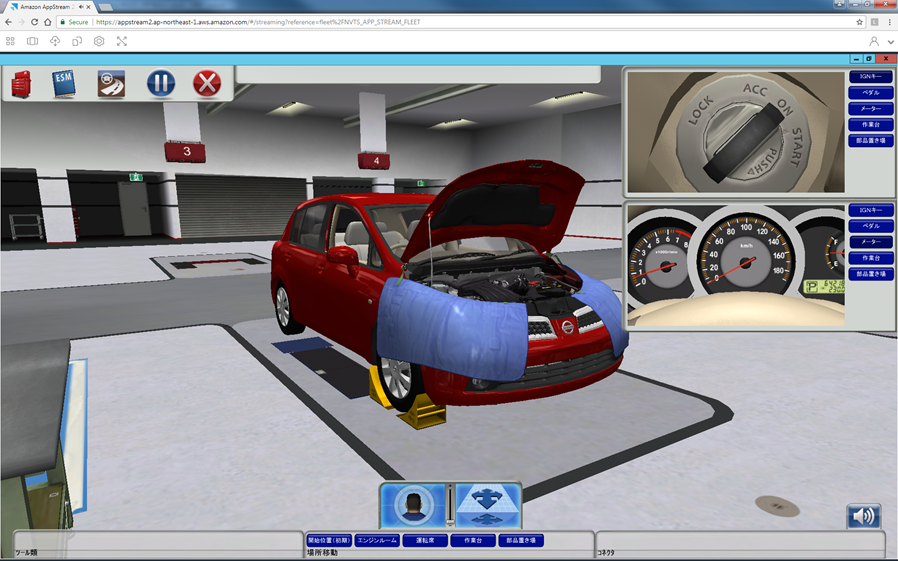AWS News Blog
New – GPU-Powered Streaming Instances for Amazon AppStream 2.0
 We launched Amazon AppStream 2.0 at re:Invent 2016. This application streaming service allows you to deliver Windows applications to a desktop browser.
We launched Amazon AppStream 2.0 at re:Invent 2016. This application streaming service allows you to deliver Windows applications to a desktop browser.
AppStream 2.0 is fully managed and provides consistent, scalable performance by running applications on general purpose, compute optimized, and memory optimized streaming instances, with delivery via NICE DCV – a secure, high-fidelity streaming protocol. Our enterprise and public sector customers have started using AppStream 2.0 in place of legacy application streaming environments that are installed on-premises. They use AppStream 2.0 to deliver both commercial and line of business applications to a desktop browser. Our ISV customers are using AppStream 2.0 to move their applications to the cloud as-is, with no changes to their code. These customers focus on demos, workshops, and commercial SaaS subscriptions.
We are getting great feedback on AppStream 2.0 and have been adding new features very quickly (even by AWS standards). So far this year we have added an image builder, federated access via SAML 2.0, CloudWatch monitoring, Fleet Auto Scaling, Simple Network Setup, persistent storage for user files (backed by Amazon S3), support for VPC security groups, and built-in user management including web portals for users.
New GPU-Powered Streaming Instances
Many of our customers have told us that they want to use AppStream 2.0 to deliver specialized design, engineering, HPC, and media applications to their users. These applications are generally graphically intensive and are designed to run on expensive, high-end PCs in conjunction with a GPU (Graphics Processing Unit). Due to the hardware requirements of these applications, cost considerations have traditionally kept them out of situations where part-time or occasional access would otherwise make sense. Recently, another requirement has come to the forefront. These applications almost always need shared, read-write access to large amounts of sensitive data that is best stored, processed, and secured in the cloud. In order to meet the needs of these users and applications, we are launching two new types of streaming instances today:
Graphics Desktop – Based on the G2 instance type, Graphics Desktop instances are designed for desktop applications that use the CUDA, DirectX, or OpenGL for rendering. These instances are equipped with 15 GiB of memory and 8 vCPUs. You can select this instance family when you build an AppStream image or configure an AppStream fleet:

Graphics Pro – Based on the brand-new G3 instance type, Graphics Pro instances are designed for high-end, high-performance applications that can use the NVIDIA APIs and/or need access to large amounts of memory. These instances are available in three sizes, with 122 to 488 GiB of memory and 16 to 64 vCPUs. Again, you can select this instance family when you configure an AppStream fleet:

To learn more about how to launch, run, and scale a streaming application environment, read Scaling Your Desktop Application Streams with Amazon AppStream 2.0.
As I noted earlier, you can use either of these two instance types to build an AppStream image. This will allow you to test and fine tune your applications and to see the instances in action.
Streaming Instances in Action
We’ve been working with several customers during a private beta program for the new instance types. Here are a few stories (and some cool screen shots) to show you some of the applications that they are streaming via AppStream 2.0:
AVEVA is a world leading provider of engineering design and information management software solutions for the marine, power, plant, offshore and oil & gas industries. As part of their work on massive capital projects, their customers need to bring many groups of specialist engineers together to collaborate on the creation of digital assets. In order to support this requirement, AVEVA is building SaaS solutions that combine the streamed delivery of engineering applications with access to a scalable project data environment that is shared between engineers across the globe. The new instances will allow AVEVA to deliver their engineering design software in SaaS form while maximizing quality and performance. Here’s a screen shot of their Everything 3D app being streamed from AppStream:
Nissan, a Japanese multinational automobile manufacturer, trains its automotive specialists using 3D simulation software running on expensive graphics workstations. The training software, developed by The DiSti Corporation, allows its specialists to simulate maintenance processes by interacting with realistic 3D models of the vehicles they work on. AppStream 2.0’s new graphics capability now allows Nissan to deliver these training tools in real time, with up to date content, to a desktop browser running on low-cost commodity PCs. Their specialists can now interact with highly realistic renderings of a vehicle that allows them to train for and plan maintenance operations with higher efficiency.

Cornell University is an American private Ivy League and land-grant doctoral university located in Ithaca, New York. They deliver advanced 3D tools such as AutoDesk AutoCAD and Inventor to students and faculty to support their course work, teaching, and research. Until now, these tools could only be used on GPU-powered workstations in a lab or classroom. AppStream 2.0 allows them to deliver the applications to a web browser running on any desktop, where they run as if they were on a local workstation. Their users are no longer limited by available workstations in labs and classrooms, and can bring their own devices and have access to their course software. This increased flexibility also means that faculty members no longer need to take lab availability into account when they build course schedules. Here’s a copy of Autodesk Inventor Professional running on AppStream at Cornell:

Now Available
Both of the graphics streaming instance families are available in the US East (N. Virginia), US West (Oregon), Europe (Ireland), and Asia Pacific (Tokyo) Regions and you can start streaming from them today. Your applications must run in a Windows 2012 R2 environment, and can make use of DirectX, OpenGL, CUDA, OpenCL, and Vulkan.
With prices in the US East (N. Virginia) Region starting at $0.50 per hour for Graphics Desktop instances and $2.05 per hour for Graphics Pro instances, you can now run your simulation, visualization, and HPC workloads in the AWS Cloud on an economical, pay-by-the-hour basis. You can also take advantage of fast, low-latency access to Amazon Elastic Compute Cloud (Amazon EC2), Amazon Simple Storage Service (Amazon S3), AWS Lambda, Amazon Redshift, and other AWS services to build processing workflows that handle pre- and post-processing of your data.
— Jeff;
